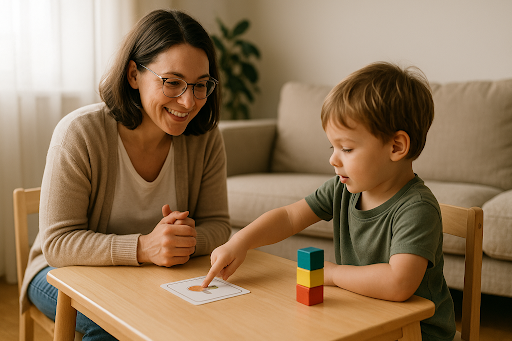ABA therapy growth is not always rapid.
Not every achievement is celebrated. The most significant development is frequently made in the background. It occurs gradually and is incorporated into the routine of daily living, which contains many factors that may not initially appear spectacular.
The purpose of this blog is to share what may be comparatively small victories. They do, however, count. Also, they form the foundation of our long-term success.
Even if you’re not seeing the desired development, it still happens. What you may be missing is the slow and steady progress that provides the foundation for something more permanent.
Why Small Steps Are a Big Deal
In ABA therapy, we tend to focus on what is clear: first words, entire sentences, independent routines, and a decrease in problematic behaviors. Those are fantastic markers that we should celebrate. However, if we focus solely on the larger picture, we risk overlooking the minor efforts that contribute to it.
In the case of a child who has been in therapy for weeks but has yet to pronounce a new word, they will turn their head upon hearing their name. Or the child who has not previously participated in group play, yet does not leave once it begins. These are hardly large-scale changes, but they are clear indicators that progress is being made. This is what ABA therapy looks like for growth, which may not appear on a report.
The truth is that most progress occurs between milestones, in the pauses, adjustments, and almost-there moments. It is in the number of attempts a child makes before succeeding. It’s in how well they recover from a meltdown the next time. It is also in the minor decisions people make for themselves, which may go unnoticed.
Tools That Help You See the Full Picture
Amid daily routines in ABA therapy support, you may notice little to no outcomes, leading you to question the effectiveness of the tactics you are employing or whether your child is making any progress at all. This is when the appropriate tools come to the rescue, not just for the therapists but also for the families.
- ABA progress monitoring is a technique for experts to track what is working, what is changing, and which route to take next. But this doesn’t mean we’re just looking at graphs and data; we’re narrating the story of your child’s development step by step.
- ABA frequency measurement is a way of measuring how often a behavior happens. For example, how many times a day does a child ask for help rather than grow frustrated? Also, how frequently do they respond to their names? Note that these may develop gradually, but seeing any growth at all is very encouraging.
- ABA duration tracking tracks how long a behavior lasts. For example, consider a child who used to spend 20 minutes on a challenging behavior but now only spends 5. This is not simply numbers; it is progress. Furthermore, development may go unreported.
These strategies are presented using basic ABA progress tools such as graphs, digital apps, behavior monitoring sheets, and therapist-provided daily reports. However, contact between therapists and families appears to be the most effective strategy. When both are focused on the finer features, they become simpler to identify and enjoy.

Signs of Subtle Progress You Might Be Missing
1. Behavioral Shifts That Signal Readiness
Your child may appear more composed in response to previously significant concerns, such as a new sound, a different chair, or a change in routine. You may notice that they think before reacting, halt for a moment, or come to you for comfort. What you may see as a behavioral stop is the beginning of emotional regulation.
Track with:
- ABA frequency measurement: Count the number of times your child employs a coping skill rather than a meltdown.
- ABA length tracking: Watch how they recover from a difficult situation.
2. Small Steps Toward Independence
Maybe your child hasn’t entirely mastered an activity on their own yet, but they’re taking the first steps in that direction. For example, they may place the toothbrush in their mouth without your permission or bring the plate to the sink after a meal. These may not be large-scale accomplishments, but they are signs of executive function development over time.
Track with:
- ABA reports show baseline behaviors and compare them to current routines.
- ABA will employ tools like visual schedules and token boards, which will promote regularity.
3. Growth in Communication (Even Without Words)
Your child may not be able to speak in complete words at this stage, which is okay, but they may be grasping your hand when they want something or pointing out kitchen objects. These are early examples of expressive communication. Some children will begin with gestures or pictures before transitioning to words.
Track with:
- Frequency tracking of requests (verbal or nonverbal).
- Duration tracking of eye contact or joint attention activities.
4. Choosing Connection
One day, you may notice your toddler sitting a little closer in play. It’s also possible that your child is more interested in the acts of a sibling than in the outside world. As you focus on larger social challenges, you may overlook these tiny gestures toward connectedness. However, keep in mind that they are the foundation around which all of our relationship building is built.
Track with:
- ABA frequency measurement: How frequently does the child seek and respond to social interaction?
- ABA progress notes include therapist reports as well as parental input.
5. Recovery Over Perfection
Sometimes we focus on completely stopping a behavior. However, a child who used to take 30 minutes to settle down after a trigger and now does it in 10 is one example of progress. Shorter, less intense reactions demonstrate emotional resilience, as well as the effectiveness of the techniques we are implementing.
Track with:
- Duration tracking: The time required to recover from dysregulation.
- Progress reports assess the intensity of behaviors across several weeks or months.
6. Learning Without Prompting
When a child begins to accomplish what we want of them, such as wave goodbye, follow directions, or use a learned word, the skill becomes second nature to them. It is taking root.
Track with:
- ABA progress aids, including prompt level charts.
- Monitoring the use of prompts that are no longer needed.
Signs of Progress & How to Track Them
| Subtle Sign | What It Looks Like | How to Track It |
| Emotional Regulation | Calming down faster after being upset | ABA duration tracking; incident notes |
| Increased Engagement | Sitting longer in circle time or group play | Frequency count of sustained participation |
| Communication Attempts | Pointing, gesturing, or eye contact to request | Frequency tracking, therapist reports |
| Initiating Independence | Beginning routines on their own | Parent journals: ABA progress reports |
| Social Curiosity | Watching or imitating peers | Observation logs: frequency of social interactions |
| Reduced Prompts | Following directions with fewer reminders | Prompt fading charts; ABA frequency measurement |
How Willow Reach ABA Helps Children Thrive
We believe in supporting each child in the areas that are most important to them as they grow at their speed, in secure environments with people who know them best.
- In-home ABA Therapy: At home, we assist your child with their daily routines, such as dressing, playing, and eating together.
- Center-Based Therapy (coming soon): Willow Reach ABA will offer center-based ABA services for children who thrive in a more organized environment.
- Caregiver Coaching and Support: Willow Reach ABA features a platform for caregivers that is updated frequently. We also offer a user-friendly environment.

A Closer Look at Subtle ABA Progress in Action
A mother sat on the floor of the living room with her child. They had been getting ABA training at home for a few weeks. She had been paying close attention to everything he did, including every pause and look.
She had been working on big goals for weeks, like being able to speak in full sentences, stay calm during meals, and play with other kids.
Something different happened that afternoon, though.
Her son, who had a hard time with changes in the past, saw his therapist pick up the toys. He put one of the bricks back in the bin without getting angry or running away.
A simple thing to do. It was only five seconds long. But it meant everything to that family. That meant he knew what to do. He didn’t freak out because he felt safe. He was beginning to connect what he had learned with what was going on around him.
There was a moment that may not have been noticed before that showed real, observable growth and, more importantly, real hope. Most of the time, growth in ABA therapy looks like small changes that show something is beginning to click.
Therapists and families who see these times together change the way they think about success. There is less pressure to be perfect and more pressure to be there, stick with it, and work together.
Conclusion: Progress Is Happening, Even When It’s Quiet
When we are waiting for the big things, we tend to ignore the minor details. In ABA therapy, we notice that improvement is typically very quiet, consistent, and sluggish. That is okay; it is the reality.
As we shift away from a single great win mindset, we notice that many changes are occurring. Small meltdowns. A shared look. Time alone. These are more than just evidence of development; they are the foundation of what is to come.
ABA therapy results in more than just goal achievement; we see growth in connections developed, self-confidence gained, and day-to-day tasks made easier. With the correct assistance, tools, and strategy, you may also see the full worth of your progress.
Frequently Asked Questions About ABA Progress (FAQs)
- How long does it typically take to notice subtle changes in ABA therapy?
Most parents report seeing small gains during the first 3 to 6 months, such as better eye contact, the child following through on simple directions, or a reduction in demanding behavior. These early successes may be limited in scale, but they demonstrate that the therapy is having an influence. Consistent ABA progress monitoring highlights these minor changes.
- What should I do if I feel my child’s ABA program isn’t focusing on goals that matter to us?
You are your child’s best expert. Be proactive and state what you value (for example, boosting social skills or lowering stimming) and have your therapy team change tracking measures such as ABA frequency and length to meet those objectives.
- How do I know whether Willow Reach ABA’s in-home coaching truly supports our family?
Families tell us that the virtual care model, like that of Willow Reach ABA, which includes weekly remote check-ins, is beneficial. We see these as instruments for putting concepts into practice on a daily. This enhances ABA outcomes as well as your confidence in your participation in your child’s development outside of official sessions.
- Can Willow Reach ABA help with managing meltdowns and emotional regulation?
Yes, they give coping methods and track indications, including how quickly a child recovers from dysregulation. Therapists can change supports by using ABA progress reports and ABA tools in their repertoire, and they can also instruct parents on which soothing techniques to utilize, resulting in a decrease in the severity and duration of episodes.
- What are some signs of progress in ABA therapy that don’t show up on a progress report?
We observe children respond better to changes in routine, require less prompting to begin a task, or be interested in other children’s activities. Although they may not yet have met a predetermined goal, this is clear evidence that your child is receiving the care they require from therapy and is developing emotionally and socially.
